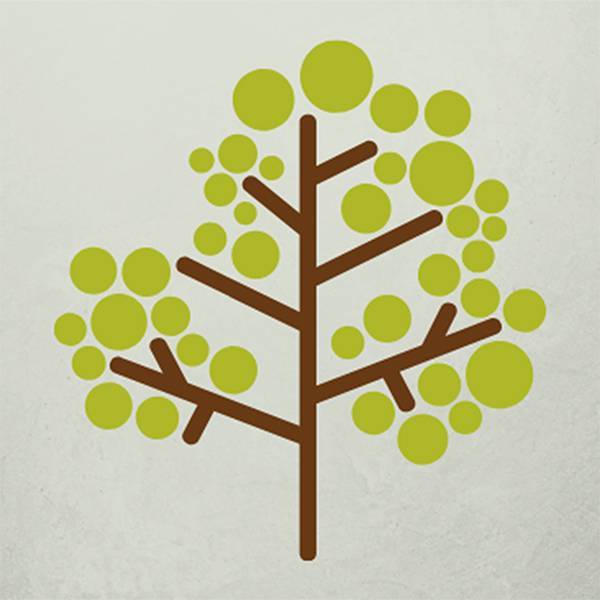Beautiful Plants For Your Interior
Difference Between Annual Perennial and Biennial Plants | Explained Simply

Understanding the difference between annual perennial and biennial plants is one of the first steps to smarter gardening. Some plants flower and fade within a single season, others return year after year, and a few need two seasons before they bloom. By knowing how these lifecycles work, you can choose plants that give both instant colour and long-term structure.
Additional sources: RHS Annuals & Biennials
Knowing these simple but often misunderstood distinctions can help you decide which plants to include when planning your garden.

Difference Between Annual, Perennial, and Biennial Plants: French Marigolds are a popular annual amongst the British gardening fraternity.
French Marigolds remain one of the most widely grown bedding plants in the UK. They are valued for their long flowering season and their ability to deter pests, according to the RHS Tagetes patula plant page.”
Additional sources: Gardeners’ World – How to grow marigolds
Each type of plant has its own unique growth patterns and care requirements. Annuals, like marigolds and petunias, need to be replanted every year. Perennials, such as peonies and lavender, return each season, while biennials like hollyhocks and foxgloves only flower in their second year. Understanding these flowering lifecycles can affect your gardening strategy, from planting schedules to maintenance needs.
Whether you’re a seasoned gardener or just starting out, grasping these differences will enhance your gardening experience. You can create a vibrant garden that offers blooms throughout the year by selecting the right mix of annuals, perennials, and biennials.
Key Takeaways
- Annuals must be replanted each year.
- Perennials thrive for multiple years, returning every season.
- Biennials grow for two years, flowering in their second year.
Hopefully, this video below will help you understand a little better.
Understanding Plant Lifecycles
Difference Between Annual, Perennial, and Biennial Plants: It’s important to understand a plant’s life cycle.
Plant lifecycles vary significantly between different types of plants. Recognising these differences helps you choose the right plants for your garden and understand their growth patterns.
Definition of an Annual Plant
Annuals live fast and die young. They sprout, flower, set seed, and complete their lifecycle in one growing season. Gardeners choose them for quick impact and reliable colour in borders, pots, and hanging baskets..
Key Traits of Annuals:
- Germination: Seeds usually sprout in spring.
- Types: There are warm-season annuals, like petunias and marigolds, that thrive in summer heat.
- Growth: These plants offer instant colour to your garden, and some self-seed, spreading their beauty year after year.
- Maintenance: After flowering, they typically require little care, making them ideal for many gardeners.
Examples of annuals in the UK:
- French Marigolds
- Sunflowers
- Petunias
- Sweet Peas
Recommendation: Use annuals if you want fast colour for a new border or patio display. Pair them with perennials for a layered look that lasts beyond one season.
What Are Biennial Plants?
Biennials take two years to complete their lifecycle. In year one they grow leaves and roots; in year two they flower, set seed, and die. In mild conditions, some may behave like short-lived perennials.
Examples of Biennials:
- Foxgloves
- Hollyhocks
- Sweet William
- Parsley
Recommendation: Use biennials to add drama and height. Plant them alongside perennials so your borders don’t look bare in year one.
What Are Perennial Plants?
Perennials live for several years, returning each season once established. They may die back in winter but re-emerge in spring, bringing structure and continuity. Lifespan varies: some last just a few years, while others (like peonies) can thrive for decades.
Examples of Perennials
- Lavender
- Echinacea
- Hosta’s
- Peonies
Recommendation: Invest in perennials for long-term value. Choose nectar-rich types to attract pollinators and add resilience to your garden.
(For further reading: RHS on plant ageing).
Understanding the differences between annuals, biennials, and perennials helps you create a garden that remains interesting across all seasons.
Gardening Considerations for Different Plant Types
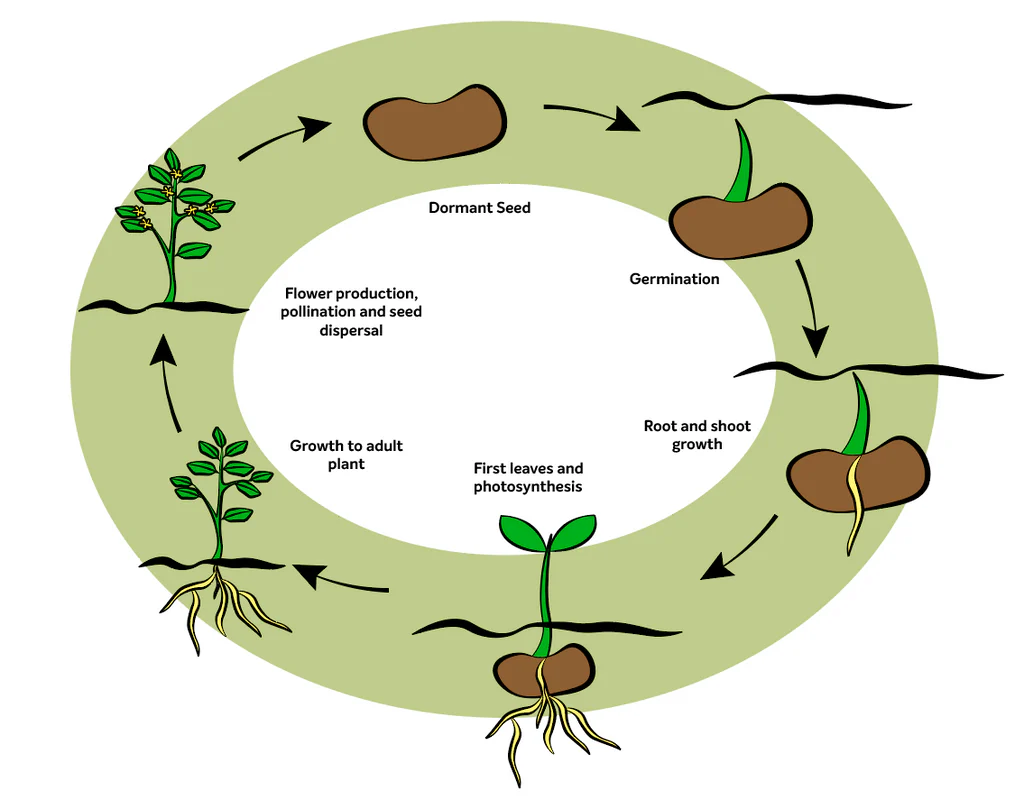
Difference Between Annual, Perennial, and Biennial Plants: The life cycle all plants go through at certain stages of their growth.
When choosing plants for your garden, understanding the unique needs of annuals, biennials, and perennials is crucial. Each type has specific maintenance requirements and growing conditions that can affect the overall success of your garden.
Gardening with Annuals
As we have discovered, annuals are plants that complete their life cycle in one growing season. This means you need to replant them every year. Popular choices include zinnias, marigolds, and cosmos. These flowers thrive in warmer temperatures and can add vibrant colour to your garden.
Because annuals need consistent moisture, be sure to water them regularly, especially in dry spells. Applying mulch can help retain soil moisture and reduce weeds. For best results, choose hardy annuals if you live in areas with unpredictable frost. Planning your planting schedule is important to ensure you enjoy blooms throughout the season.
Spotlight: French Marigolds
French Marigolds (Tagetes patula) are among the most popular bedding plants in Britain. They offer long-lasting flowers and are often grown to deter pests (companion planting). According to the RHS plant profile, they’re easy to grow and bloom reliably from summer to frost.
If you’d like a step-by-step guide, see Gardeners’ World’s article on marigolds
Gardening with Biennials
Biennials require two growing seasons to complete their life cycle. In the first year, they focus on growing foliage, and in the second year, they bloom. Popular biennials like foxglove, hollyhock, forget-me-not, and sweet william can enhance your garden with unique flowers and textures.
When planting biennials, consider spacing them appropriately to allow for growth. It’s good to seed them in the autumn for spring flowering. Amend the soil with organic matter to promote healthy growth. After blooming, remember these plants may die back, so plan for replacements or companions to maintain garden interest.
Gardening with Perennials
Perennials are plants that come back year after year. Popular options include phlox, Echinaceas (coneflower), lavender, yarrow, and hostas. They often require less maintenance over time compared to annuals, making them a great choice for low-maintenance gardens.
When planting perennials, ensure you choose the right location based on their soil, sunlight and moisture needs. For example, lavender prefers sandy, nutrient-poor soils in full sun, as you can see some perennials thrive in full sun, while others prefer shade. Many will go dormant in winter, so plan to mulch to protect the roots. Regular deadheading and division every few years can keep your perennials healthy and prolific.
Seasonal Impacts on Plant Development
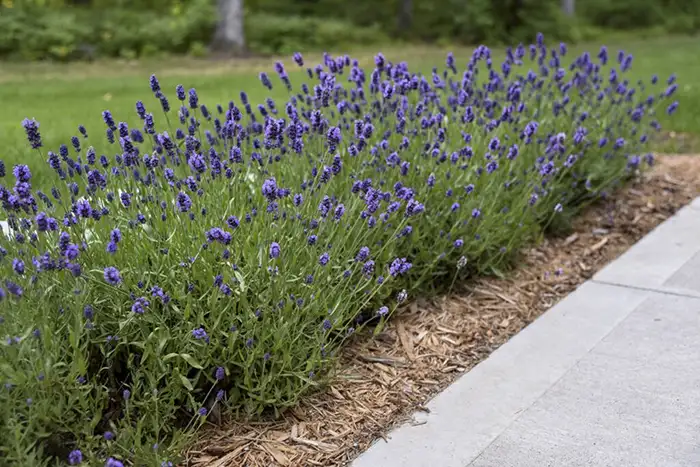
Difference Between Annual, Perennial, and Biennial Plants: Lavender perennial) prefers full sun and poor sandy soils.
Seasonal changes significantly affect the life cycles and growth patterns of different types of plants. Understanding these impacts can help you plan your garden effectively.
Annuals and Seasonal Temperatures
Annual plants, like geraniums, marigolds, and petunias, complete their life cycles in one growing season. They germinate, grow, flower, and set seeds before dying off with the cold temperatures of winter. The ideal growth temperature for these plants is typically between 60°F – 77°F or (15°C – 25°C).
As the growing season advances into early spring, annuals thrive, utilising warming temperatures to grow robustly. In autumn, as temperatures drop, they start to decline. Without the warmth, these plants cannot survive the winter. Hence, you need to replant them every year unless they self-seed.
Biennials Through the Seasons
Biennial plants, such as foxglove and hollyhock, have a two-year life cycle. In the first year, they focus on developing their foliage and root systems. This phase often occurs in the spring and summer when temperatures are warmer.
In the second year, biennials produce flowers and seeds, often blooming in early spring or summer. During winter, these plants enter a dormant phase, withstanding cold temperatures. If you plant biennials in the autumn, ensure they are well-established to survive the harsh winter conditions until they bloom.
Perennials and Seasonal Changes
Perennials, like roses, peonies, and hosta’s however, live for multiple years, often returning each spring after a winter dormancy. Their life cycle is marked by a period of active growth, flowering, and dormancy.
Winter is crucial for perennials, as they rely on colder temperatures to enter dormancy. This helps them conserve energy. As spring arrives, warmer temperatures signal these plants to start growing again. Different perennials bloom at various times, from spring through autumn. Understanding these blooming patterns can help you design a garden that ensures continuous colour and interest throughout the various seasons.
Popular Varieties of Each Plant Type
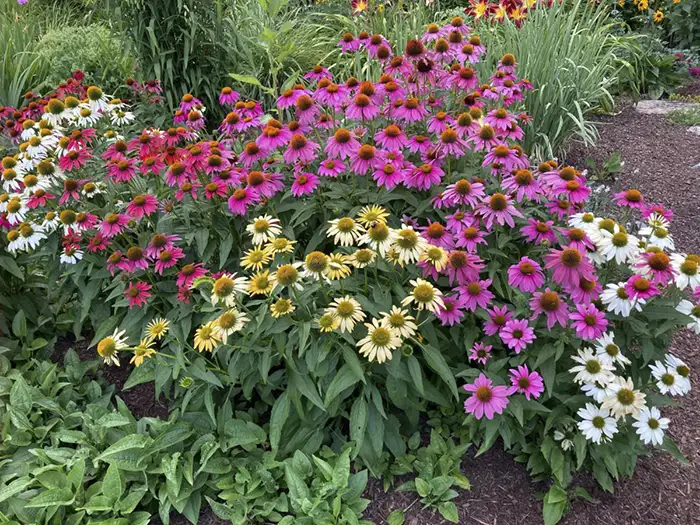
Difference Between Annual, Perennial, and Biennial Plants: Perennials like Echinaceas (Coneflowers) need around 6-8 hrs of sun a day in amended well-drained soil.
Understanding the variety within annual, biennial, and perennial plants helps you choose the best options for your garden. Each type has its popular representatives, valued for their unique features and uses.
Notable Annual Plants
Annual plants complete their life cycle in one growing season, providing vibrant blooms and harvests throughout the year. Some notable annual flowers include:
- Geraniums: These are colourful and easy to care for, perfect for containers or garden beds. They thrive in sunny locations and bloom from spring until frost.
- Zinnias: Known for their daisy-like appearance, zinnias come in many bright colours. They attract butterflies and grow well in various conditions.
- Petunias: These are popular for their sprawling growth and striking colours. They are commonly used in hanging baskets and summer displays.
- French Marigolds: Easy to grow, these brightly coloured flowers help deter pests in vegetable gardens and appreciate full sun.
- Cosmos: These delicate flowers are known for their feathery foliage and can thrive in poor soil. They bloom in shades of pink, white, and red.
Notable Biennial Plants
Biennial plants have a two-year life cycle, growing foliage in the first year and flowering in the second. Popular biennials include:
- Foxglove: Recognised for its tall spikes of tubular flowers, this plant is a favourite in cottage gardens. It attracts bees and thrives in partial shade.
- Hollyhock: These plants provide striking vertical accents in gardens, producing large, colourful blooms. They prefer full sun and can grow quite tall.
- Parsley: Often used as a culinary herb, parsley grows leaves in its first year and can flower in its second. It prefers rich, well-drained soil.
- Carrots: Commonly grown in home gardens, they are usually harvested in their first year, but can also flower in the second if left unharvested.
Notable Perennial Plants
Perennial plants return year after year, making them staples in many gardens. Some notable perennials include:
- Coneflowers: Known for their daisy-like shape and hardiness, these flowers are drought-tolerant and attract pollinators.
- Lavender: Valued for its fragrance and beauty, lavender thrives in well-drained soil and full sun. It’s also useful for making herbal teas and sachets.
- Peonies: These elegant flowers bloom in late spring and are long-lived. They can produce lavish blooms and are often passed down through generations.
- Hostas: Popular for their lush, leafy appearance, hostas thrive in shaded areas and add texture to garden designs.
- Daylilies: These hardy plants produce blooms that last only a day but continue to flower throughout the season, providing constant colour.
- Asters: Blooming in late summer to fall, these flowers add vibrant colour to your garden at a time when many others have faded.
Maintenance and Care Strategies
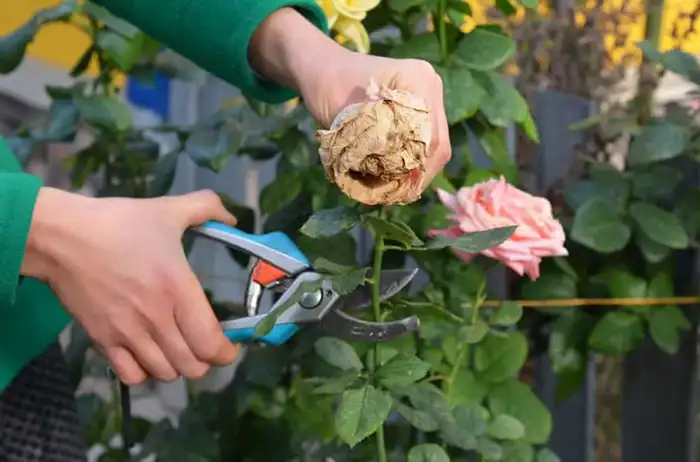
Difference Between Annual, Perennial, and Biennial Plants: Perennials like ‘roses’ benefit from maintenance – ‘dead-heading’ roses help to divert the plant’s energy from producing ‘rose hips’ to making more flowers.
When caring for plants, it’s important to know the specific needs of annuals, biennials, and perennials. Each type requires different maintenance strategies to thrive. Here are some tailored approaches for each plant category.
Caring for Annuals
Annuals need consistent care throughout their short life cycle. Replanting is necessary each year since they complete their lifecycle in one season. Choose a sunny location with well-drained soil to encourage growth.
- Watering: Keep the soil moist but not waterlogged. Water deeply, especially during dry periods.
- Fertilisers: Use a balanced fertiliser every few weeks to promote lush growth and vibrant blooms.
- Deadheading: Regularly remove spent flowers to encourage more blooms and extend the flowering period.
- Pest Control: Check for common pests like aphids and act quickly to manage any infestations.
Caring for Biennials
Biennials require more patience, as they grow for two seasons. In the first year, focus on leaf development. In the second year, they will produce flowers. Choose a spot with partial to full sunlight.
- Soil Preparation: Ensure good soil quality before planting, adding compost for nutrients.
- Watering: Maintain consistent moisture, especially during the flowering stage.
- Self-Seeding: Some biennials may self-seed. Allow some flowers to develop seeds for the next season’s growth.
- Mulching: Use mulch to retain moisture and suppress weeds, improving overall plant health.
Caring for Perennials
Perennials can survive for many years, making them a wise long-term choice for gardens. They typically die back in winter and re-emerge in spring.
- Planting Location: Choose a location suited to the various light and soil preferences of your perennials.
- Watering: Water them well during their establishment period, but reduce frequency once they’re established.
- Maintenance: Regularly check for dead or damaged stems and cut them back to promote new growth.
- Tender Perennials: For tender varieties, consider protecting them from frost or bringing them indoors during cold months.
By understanding these maintenance and care strategies, you can ensure that your plants thrive and beautify your garden.
Choosing the Right Plants for Your Garden
Here’s a simple guide to combining all three types:
- Want instant impact? Go heavy on annuals.
- Want reliability and structure? Prioritise perennials.
- Want drama and surprise? Add biennials for extra height and natural reseeding.
Pro Tip: A layered mix of annuals, perennials, and biennials ensures colour every season and reduces replanting effort over time.
Conclusion
When you know the difference between annual perennial and biennial plants, you can make confident choices that suit your garden style and goals. Whether you want quick summer colour, reliable year-after-year growth, or the charm of biennials, the right mix will give you beauty and structure all season long.
By considering these life cycles in garden planning, gardeners can create dynamic, sustainable, and beautiful spaces that provide interest throughout the year while managing maintenance requirements effectively.
Whether choosing quick-blooming annuals for seasonal colour, reliable perennials for long-term structure, or fascinating biennials for unique seasonal displays, knowledge of plant life cycles enables informed decisions that lead to gardening success.
FAQ’s
Can a Perennial Plant Ever Behave Like an Annual?
Yes, perennial plants can sometimes behave like annuals depending on climate conditions. For example, plants that are perennial in warm climates (like geraniums or snapdragons) are often grown as annuals in colder regions because they cannot survive harsh winters. Gardeners in cold climates often treat these “tender perennials” as annuals, replanting them each spring.
Why do my Biennial Vegetables Bolt in Their First Year?
Premature bolting (flowering) in biennial vegetables can occur due to several stress factors:
– Extreme temperature fluctuations
– Extended periods of cold followed by warm weather
– Drought stress
– Root disturbance
– Late planting
When these plants experience stress, they may skip their normal two-year cycle and go straight to seed production as a survival mechanism. To prevent bolting, maintain consistent growing conditions and plant at the appropriate time for your climate.
How Can I Tell if a Plant is Annual, Perennial, or Biennial Before Purchasing?
– Several methods can help identify a plant’s life cycle:
– Check the plant label or seed packet
– Look up the botanical name in gardening references
– Ask garden centre staff
Observe the root structure (perennials often have more developed root systems)
Research the plant’s native habitat and growing conditions
Keep in mind that some plants may be labelled differently depending on your growing zone, as their lifecycle can vary by climate.
